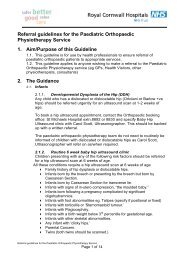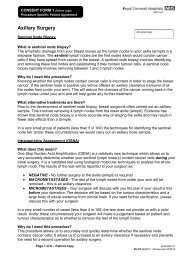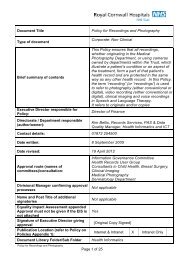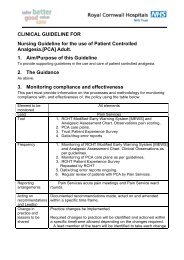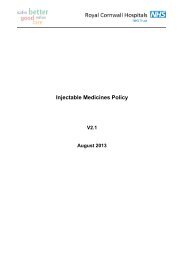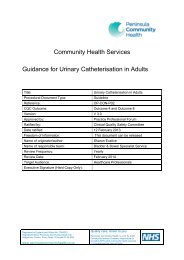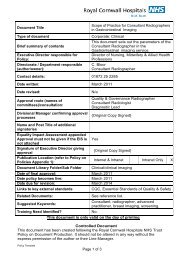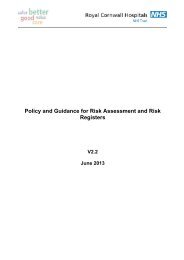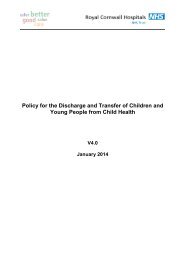Buccal Midazolam Shared Care Guideline - the Royal Cornwall ...
Buccal Midazolam Shared Care Guideline - the Royal Cornwall ...
Buccal Midazolam Shared Care Guideline - the Royal Cornwall ...
You also want an ePaper? Increase the reach of your titles
YUMPU automatically turns print PDFs into web optimized ePapers that Google loves.
BUCCAL MIDAZOLAM FOR THE TREATMENT OF PROLONGED SEIZURES IN CHILDREN<br />
This shared care guideline sets out details for <strong>the</strong> sharing of<br />
care of epileptic children requiring treatment for prolonged<br />
seizures (> 5 minutes) in <strong>the</strong> community. These guidelines<br />
provide additional limited information necessary to aid in <strong>the</strong><br />
treatment of <strong>the</strong>se patients. As with all shared care guidelines<br />
<strong>the</strong>y highlight relevant prescribing issues but should be used in<br />
conjunction with relevant guidance and do not replace <strong>the</strong>m.<br />
INDICATIONS FOR THE PURPOSES OF THIS GUIDELINE<br />
<strong>Buccal</strong> midazolam is indicated for <strong>the</strong> treatment of<br />
epileptic seizures lasting more than five minutes to<br />
prevent <strong>the</strong> development of status epilepticus. Note that<br />
some patients may be advised on an individual basis to<br />
wait ei<strong>the</strong>r slightly shorter or longer than 5 minutes.<br />
<strong>Buccal</strong> midazolam is frequently used in paediatrics as an<br />
alternative to rectal diazepam<br />
PREPARATIONS AND DOSAGE<br />
<strong>Buccal</strong> midazolam is dosed by age as described in <strong>the</strong><br />
table below. It is available as a 10mg/mL solution<br />
(Epistatus pre filled syringe) which may be given buccally<br />
to treat prolonged seizures lasting longer than 5 minutes.<br />
Note that some patients may be advised on an individual<br />
basis to wait ei<strong>the</strong>r slightly shorter or longer than 5<br />
minutes.<br />
Age of patient Dose of buccal midazolam<br />
6 – 12 months 2.5mg (0.25mL)<br />
1 – 4 years 5mg (0.5mL)<br />
5 – 9 years 7.5mg (0.75mL)<br />
10 years and over 10mg (1mL)<br />
There is a dose for children up to 6 months of age<br />
(300micrograms/kg, maximum dose of 2.5mg).<br />
Consultant will provide individualised administration<br />
guidelines for <strong>the</strong> family which will also be available to<br />
<strong>the</strong> GP.<br />
CONTRAINDICATIONS AND PRECAUTIONS<br />
<strong>Buccal</strong> midazolam is contraindicated in cases of:<br />
Known hypersensitivity to midazolam or any of<br />
<strong>the</strong> excipients<br />
Acute narrow angle glaucoma<br />
Pregnancy (safety has not been established –<br />
use with caution)<br />
MONITORING<br />
No specific monitoring is necessary.<br />
SIDE EFECTS<br />
The most common side effect is drowsiness, which may<br />
last for several hours after administration. Agitation,<br />
restlessness and disorientation have been reported,<br />
although <strong>the</strong>se side effects are rare. Respiratory<br />
depression may occur at high doses.<br />
COMMON/SIGNIFICANT DRUG INTERACTIONS<br />
Erythromycin, o<strong>the</strong>r macrolides and cimetidine inhibit <strong>the</strong><br />
metabolism of midazolam – this may result in prolonged<br />
duration of sedative side effect.<br />
Because this product is unlicensed, GP computer<br />
systems may not list this product and hence coprescribing<br />
of potentially interacting drugs will not be<br />
flagged up. Practices prescribing buccal midazolam may<br />
wish to endorse patient records accordingly.<br />
Some patients may be advised by <strong>the</strong>ir secondary care<br />
clinician to consider <strong>the</strong> use of a repeat dose.<br />
<strong>Buccal</strong> midazolam is currently an unlicensed preparation<br />
manufactured in <strong>the</strong> UK under a Special’s licence.<br />
Epistatus pre-filled oral syringes are available in ready to<br />
use doses of 2.5mg, 5mg, 7.5mg and 10mg. <strong>Buccal</strong><br />
midazolam is widely used throughout <strong>the</strong> UK and is<br />
recommended in <strong>the</strong> SIGN and NICE guidelines for<br />
treatment of epilepsy. Fur<strong>the</strong>r prescribing information<br />
can be found in <strong>the</strong> BNF for Children.<br />
ADMINISTRATION<br />
The oral syringe is removed from <strong>the</strong> packaging. By<br />
slowly pushing down <strong>the</strong> plunger, approximately half of<br />
<strong>the</strong> dose is placed between <strong>the</strong> lower gums and <strong>the</strong><br />
cheek on one side of <strong>the</strong> mouth and remainder of <strong>the</strong><br />
dose given in <strong>the</strong> same way on <strong>the</strong> o<strong>the</strong>r side of <strong>the</strong><br />
mouth. Full instructions are given in <strong>the</strong> patient<br />
information leaflet found inside <strong>the</strong> carton, and <strong>the</strong><br />
<strong>Buccal</strong> <strong>Midazolam</strong> for prolonged seizures in children SCG<br />
Page 2 of 9<br />
Request for o<strong>the</strong>r<br />
formats<br />
Please ask if you would<br />
like to receive this leaflet<br />
in large print, braille, on CD or in any o<strong>the</strong>r<br />
languages. If you would like <strong>the</strong> leaflet in an<br />
alternative format please contact <strong>the</strong> PALS<br />
team<br />
on<br />
palsteam@ciospct.cornwall.nhs.uk or<br />
0845 170 8000.




